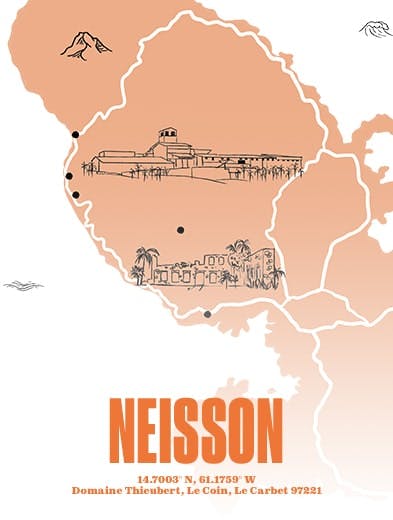Discover the Neisson distillery


Discover the Neisson distillery
Rum
In the 19th century, the region of Saint-Pierre established itself as the bastion of Martinique rum. Nicknamed the Little Paris of the Antilles, Saint-Pierre was a major exporter of rum to Europe until 8 May 1802, when the devastating eruption of Mount Pelée reduced this commercial hub to cinders.
In the late 1920s, as the Martinique sugarcane industry declined, many houses took up rum production: it is against this backdrop that Jean Neisson and his brother Adrien purchased a property in Le Carbet, a few miles from Saint-Pierre, in 1931. Today, this family distillery is the vanguard of organic agricole rum, and visitors are permitted to stroll freely between its colourful buildings to discover each stage of the transformation of sugarcane into spirits.
◊ Within the estate, orchards cultivated according to the principles of organic farming are lush with avocado, finger lime, and soursop trees, in addition to 500 mango trees — some of which stand over 30 metres tall!
◊ Built from the scrap of old tools, sculptures by Martinique artist Toussaint—Boeuf Cannes, Coupeur de Canne, Coq de Combat, Hippocampe — lurk in the alleyways. A fresco of two seahorses, tails entwined, decorates the façade of one of the cellars. It was created by Philippe Baudelocque, who is also the illustrator behind the engravings adorning several Neisson labels.
◊ In the heart of the distillery, the lemon-yellow building houses the centrepiece of the estate: the imposing Savalle copper column installed in 1931. The distillery’s square chimney, which emerges on the hillside between the red gum-trees, is of the same vintage. Its flue follows the angle of the slope (45°) over a dozen metres or so, then bends vertically to stand five metres tall.
◊ The ballet of trumpetfish, redhorses, rock lobsters, and other endemic species populating the great aquarium between the vat room and cellars is an unexpected and potentially hypnotic interlude. The marine décor includes a Neisson cask, of course.
◊ The 225L fine-grain American oak casks, specially developed by the distillery with an exclusive toasting profile (no. 105), can be glimpsed when passing by the cellars. These cellars are named ‘Mainmain’ for Germain Neisson, ‘Vevert’— nickname of Jean Neisson — and ‘Adrien’… for Adrien Neisson.
◊ The distillery’s bar prepares cocktails using the orchard’s organic fruit: lime, finger lime, or coconut, depending on the season.
◊ The estate has been producing honey for nearly 20 years. The bees living in its 400 hives gather nectar from saint-sacrament flowers, dotted lancepods, yellow mastic, and many other local plants.
◊ In Le Carbet, the restaurants lining the black sand beach offer fried balaous, fricasseed queen conch, ‘cochon roussi’ (roast pork), and titiwi accras.
◊ In the estate’s shop, bottles of Zépol’Karé illustrated by Carole Aurore, Gribouilliz, Philippe Beaudeloque, Henri Guédon, and Tatanka can be admired like so many miniature paintings.
◊ Landscape artist Jean-Philippe Thoze, who designed the distillery’s park, also designed the site of the old Habitation Anse Latouche in Le Carbet, as well as the famous Balata garden—an unmissable Martinique sight less than an hour’s drive away.
◊ In Le Carbet, the Beauregard irrigation canal, built by slaves in 1760 to provide water for the area’s distilleries, has become a memorial trail. This 9-kilometre-long hiking trail overlooks a deep valley, through which flows the Carbet River.
Neisson
Neisson


